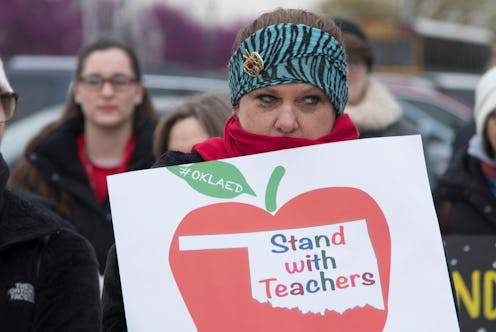
By now, you might have heard of the powerful movement in Oklahoma where thousands of teachers refused to teach classes on Monday. If you're wondering why Oklahoma teachers are on a strike, you don't have to look far beyond their salaries and classroom conditions. Most of all, though, the state's teachers say that they want more robust educational funding for their students.
For the past few weeks, Oklahoma teachers have put pressure on their state's lawmakers to increase their pay. According to the Bureau of Labor Statistics, the average annual wages for Oklahoma elementary, middle, and high school teachers are $41,150, $42,380, and $42,460 — making them some of the lowest-paid teachers in the United States.
Oklahoma teachers' salaries are remarkably lower than the national average for elementary, middle, and high school teachers. For instance, the Bureau of Labor Statistics notes that the national median wage for teachers is $59,020 at the elementary level, $59,800 for middle school teachers, and $61,420 for high school level teachers.
Teachers' concerns didn't go entirely unheard though. On Thursday, legislators passed the House Bill 1010XX which primarily focuses on increased salary for Oklahoma teachers. Going forward, the state's teachers will receive a solid $6,100 as a raise. Yet in spite of the pay raise being heralded as the "largest teacher pay raise in the history of the state" by Republican Gov. Mary Fallin, the teachers' union said it wasn't enough.
On Sunday, the union's president Alicia Priest said in a Facebook video that while the pay increase was appreciated, more needed to be done to fix the Oklahoma education system, especially with regards to the young students of the state who, Priest noted, lack basic classroom infrastructure. "We’ve all heard stories from students, parents, and teachers affected by eleven years of cuts to our classrooms. They see broken chairs in class, outdated textbooks that are duct taped together, and class sizes that have ballooned," Priest said.
Priest said that the strike on Monday will ask the state's legislators to "get back to work passing the revenue they’ve left on the table to ensure that every child in Oklahoma has access to a quality education and the opportunities they need to succeed." According to NewsOK.com, Priest said that nearly 200 out of 500 Oklahoma school districts were shut down on Monday and that "many of those [will be closed] for some time in the future until our children get what they deserve for public education."
Oklahoma teachers have shown media reporters the conditions of their classrooms — and it's not pretty. While speaking with Vox reporter Alexia Campbell, two Oklahoma teachers showed the dilapidated conditions of their students' textbooks. With their spines rotted off and pages barely held together, the students' textbooks look woeful, to say the least. On Monday morning, Campbell tweeted two photos of the books piled on each other.
The Oklahoma teachers' strike is part of a bigger wave in the United States. Teachers from various states are refusing to put up with their states' education systems and demanding better conditions for both educators and their pupils. In fact, some teachers in Oklahoma have said that they were first inspired by West Virginia teachers. In February, West Virginian teachers ignited a statewide protest and demanded better pay for themselves plus better funding for their students.
Now teachers in Oklahoma as well as Arizona and Kentucky are following their West Virginian peers' lead. The New York Times reported on signs that spelled out gratitude to the West Virginia educators. One Oklahoma teacher, Katrina Ruff, was seen carrying a sign that said, "Thanks to West Virginia." Ruff told The Times, "They gave us the guts to stand up for ourselves."